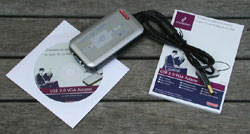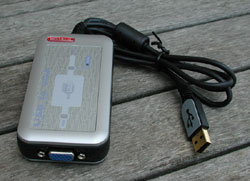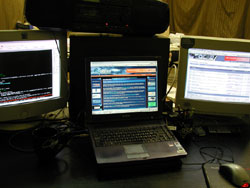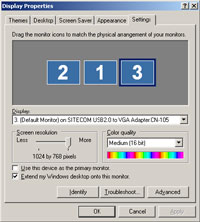|
|
Advertisement:
|
|
Sitecom USB 2.0 VGA Adapter |
|
Join the community - in the OCAU Forums!
|
Ahh, USB. Is there anything it can't do? From networking and storage to TV tuners and even desktop Christmas trees, it seems USB is truly living up to the U for Universal in its name. However, there are some tasks that we assume remain beyond USB's hot-pluggable reach - which is why I was surprised to see this gadget on a recent mailout from PC goodies distributor Anyware. "You can connect a PC monitor to your USB port", it explained - a claim that I felt had to be investigated.

The "USB 2.0 VGA Adapter CN-105" is made by Sitecom, a European company with a focus on connectivity. A nice retail box reveals an excellent manual, a driver CD and the USB connector itself.

It couldn't be much simpler. USB plug on one side, 15-pin VGA connector on the other. A little green LED on the main box lets you know when it's active. The USB cord is about a metre long and the connector is thin, so it won't interfere with other USB devices even if your ports are close together.

Installation:
The manual advises you to install the drivers before connecting the USB plug to your PC, which I duly did. Once I connected the adapter, it prompted to install the drivers and did so, twice. So I'm pretty sure I ended up installing the drivers three times. That oddness aside, it all worked fine and in no time at all the monitor connected to the USB adapter woke up and displayed a copy of my desktop background.

I'm using this on my main PC, which happens to be a laptop - Sony's VIAO PCG-FR700. One cool thing about this laptop is that it already has an additional VGA port on the back, so I'm quite used to having two screens on this PC. Most work occurs on the LCD built into the laptop, but it's nice to be able to keep a notepad window open on the other screen when researching a review, or doing up a news post, etc. IRC sometimes sits on the other screen while I read email on the main screen. But now, of course, there's three screens:

The maximum resolution supported is 1024x768 at 16-bit colour. If you must have 32-bit colour, you'll be forced to drop to 800x600. The manual explains that this is due to the maximum bandwidth available through the USB 2.0 port. I assume from this and from the name of the device that plugging into a legacy USB 1 port is not going to work well.

The little red bar installed in your system tray is presumably meant to be the Sitecom logo, although it's unreadable when that small. A little monitor picture would have been more intuitive. From this tool you can change resolutions and select the USB adapter as the primary or secondary display - or turn it off. You can't change the refresh rate here unfortunately and the default is an eyeball-vibrating 60Hz. However, you can change it as per usual via Windows Display Properties. I'm currently running the USB-connected monitor at 100Hz, which is rock-solid to the eye.
Usage:
Of course, there's no Radeon X850 or GeForce 6800 Ultra tucked away inside this little box. We can safely assume that we won't be playing Doom3 or Far Cry via this adapter. In fact, there is a slight lag when the screen is updating and you are moving the mouse. For example, if you open a webpage and move the mouse as the page loads, you'll notice the cursor moves a little jerkily. I tried to play a web-based game on the USB-connected monitor and it was too jerky to play well. Playing video is a little jerky, but bearable - doesn't look too great in 16-bit colour, though. However, this stuttering of the mouse cursor doesn't take long to become used to and has no great effect on using the monitor otherwise. You'll have your main screen for gaming, watching video or other display-intensive tasks, while something more sedate like email or wordprocessing will work fine on the USB-connected screen. Even websurfing is fine really, I barely noticed the mouse jerkiness after only a couple of hours of use.
There don't seem to be any warnings about hot-plugging this device, so I gave it a go. It works fine, disabling the extra screen in WinXP when you unplug it, and turning it back on again when you plug it back in. The only annoyance is that it seems to always switch the USB-connected monitor back to 60Hz, which is easily returned to a higher setting in Display Properties. Sometimes it seems to randomly decide to put all your desktop icons on a different monitor, but I've observed that previously with the two screens on the laptop, not just this third screen connected via USB, so I assume it's a quirk of the video drivers.
Another issue involves hot-plugging other USB devices. When plugging in my digital camera to retrieve the pictures for this review, for example, all three screens on the laptop flicked to black then back to normal. Presumably the USB controller is doing a refresh or something which triggers the display driver to behave that way. It's no big deal and the screens come back in less than a second, but the USB-connected monitor seems to always reset itself back to 60Hz again. Hopefully this can be addressed in a future driver version - there's no later drivers on Sitecom's website as yet.
I wondered if these two issues (jerky mouse and resetting to 60Hz) were due to the USB implementation on my laptop, or perhaps the video drivers, so I plugged it into a desktop motherboard's onboard USB ports. In this case ABIT's IC7, as seen in our recent Large P4 Cooler Roundup article, was used. It's running Win2K, whereas the laptop had WinXP Home preinstalled. It's also running a Radeon 9800 Pro, much quicker than the laptop's GeForce 420 Go and of course uses different drivers. The CPU is currently running at 3.5GHz, again much quicker than the laptop's mobile XP1800+. The jerkiness issue almost entirely vanished on the faster PC but the 60Hz problem remained - again, hopefully fixable with future drivers.
In terms of image quality, there may be a slight softening when running through the USB adapter, but it's so very slight that it's hard to tell. Certainly there's no obvious drop in image quality as I've seen in old KVM switches, for example.
Conclusions:
This is a handy little gadget indeed. If you have a normal desktop PC, you'd be better off buying a cheapy PCI card on Ebay and connecting your second monitor to that. For a laptop or other small PC where internal expansion is limited, or you want to easily swap a second monitor between PC's, this is ideal. There are some quirks, but it's a simple way to connect another monitor to your PC and for the most part it works well.
After using two screens on my main PC for over a year, I find it really difficult to go back to a PC with one screen. Now that I've become used to having 3 screens, thanks to this USB adapter, I miss the real-estate of the third screen when it's not plugged in. This could have become an expensive habit, but sadly, the Sitecom website advises that only one of these USB adapters can be used on a PC at a time.
Thanks to Anyware, who distribute Sitecom products in Australia, for providing the review unit. They list the RRP as AUD $139, but street prices will most likely be less. The box claims a 10-year manufacturer's warranty.
|
|
Advertisement:
All original content copyright James Rolfe.
All rights reserved. No reproduction allowed without written permission.
Interested in advertising on OCAU? Contact us for info.
|

|


